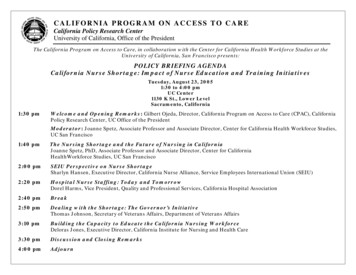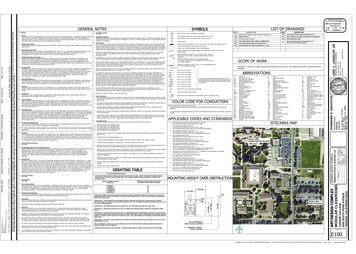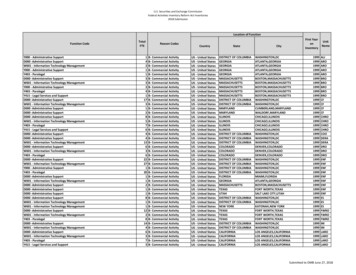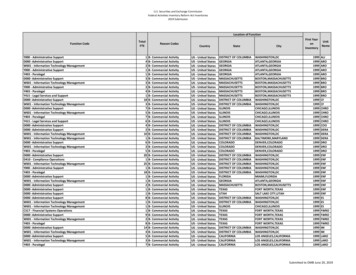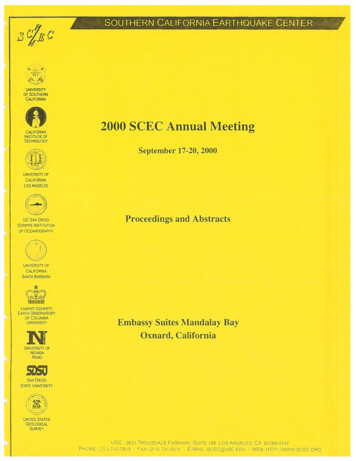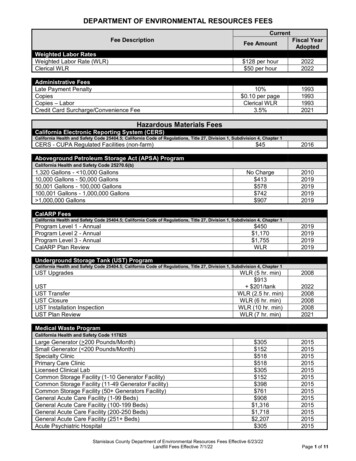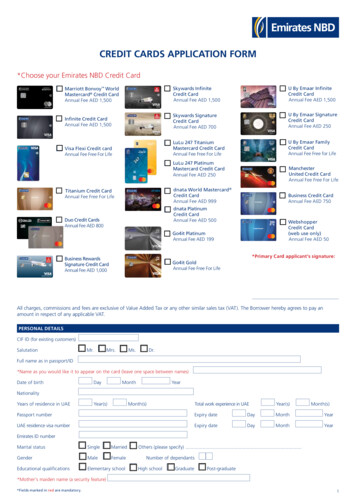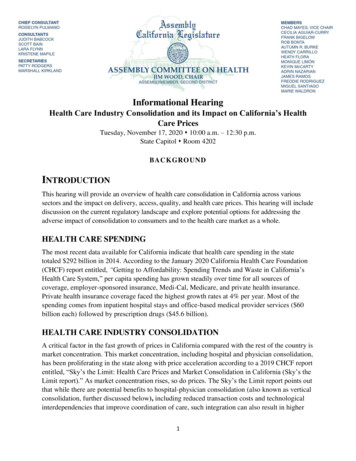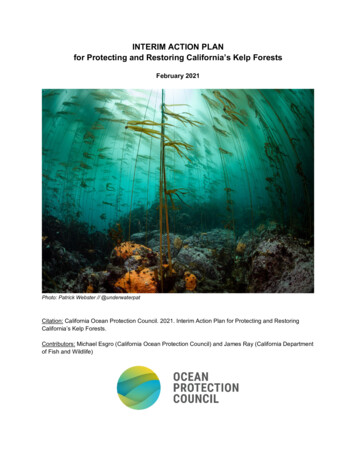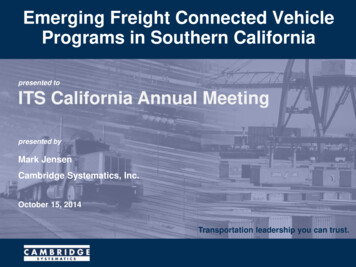
Transcription
Emerging Freight Connected VehiclePrograms in Southern Californiapresented toITS California Annual Meetingpresented byMark JensenCambridge Systematics, Inc.October 15, 2014Transportation leadership you can trust.
THE I-710 FREIGHT CAPACITYPROBLEM2
“The 710”
THE 710’S FUTURE – THE PROMISEOF CONNECTED VEHICLES Mobility at least double throughput of trucks on thededicated truck lanes through advances in vehicleautomation, V2V, and V2I communicationsEmissions leverage Connected Vehicle technologiesand goods movement efficiency (e.g. FRATIS) forsubstantially improved traffic flow to reduce fuel usageand corresponding emissions reductionsSafety virtually eliminate truck accidents throughconnected vehicle technologies and V2Vcommunications4
5
I-710 CONCEPT FOR CONNECTEDTRUCKS WITH AUTOMATION CAPABILITIES6
DEFINITIONS: “AUTONOMOUSVEHICLES”To achieve truly transformativetransportation system benefits, wemust integrate vehicle automationtechnologies with vehicle-to-vehicleand vehicle-to-roadside7
CONNECTED VEHICLE PLATOONING8
BENEFITS OF CONNECTED TRUCKSWITH AUTOMATION CAPABILITIES Safety/collision avoidanceDrive cycle smoothingPlatooning - increased fuel economyPlatooning – increased throughputSignal coordination and signageMore efficient route selectionParking space locationEmissions benefits from the aboveEconomic benefits from the aboveGoal: Make the I-710 ultra-safe and hyper-reliable to the trucking industryGateway Cities Technology Plan forGoods Movement9
WORK TO DATE Preliminary Research/Planning OEM Industry Relationships Concept of Operations Test Plan Development Infrastructure Impact AssessmentGateway Cities Technology Plan forGoods Movement10
OEM AND TEST BEDS ENGAGEMENT11
I-710 CONOPS FOR THE ZEROEMISSION FREIGHT CORRIDOR DSRC-based corridor infrastructure Connected Vehicle truck platooningoperations – moving towardsautomation capabilities Deployment in mid-2020’s -- leverage testbed opportunities over the next decadeGateway Cities Technology Plan forGoods Movement12
1In Tier 1 the I-710 ZE FreightCorridor would have traditionaltraffic control devices such as: Speed/volume detectors CCTV surveillance cameras CMS for traveler information2The more advanced trucks will comewith systems to improve safety andreliability utilizing radars, cameras andother on-board safety systems. Thesetrucks still operate independently anddo not communicate with other trucksor anything on the roadside.3Features on fully equipped trucks inTier I include: Adaptive Cruise Control Dynamic Brake Support Overtaking Assist Lane Departure Warning Systems4The driver has overall control and issolely responsible for safe operation ofthe truck. The driver can choose tocede limited control to the vehicle.Tier 1
1In Tier 2 the traditionaltraffic control devices wouldremain, although new invehicle systems wouldbegin to provide much ofthis information.2 Trucks with advanced systems wouldbegin to penetrate the marketplace withover half the vehicles having nearlyautonomous features such asCooperative Cruise Control.3In Tier 2 some trucks now begin tohave Vehicle-to-Vehicle communicationsharing, thereby increasing safetysignificantly. Even at this level, thesetechnologies support increasedreliability and are a benefit to I-710throughput.4The driver still has overall control and issolely responsible for safe operation ofthe truck. The driver can choose tocede more control to the vehicle.Tier 2
1In Tier 3 the traditional traffic control deviceswould not be needed any more. All travelerinformation (including tolling etc.) would bedone in-vehicle.2Trucks with advanced systems woulddominate the marketplace with thetrucks having fully autonomousfeatures. At this stage shorterheadways could be utilized, therebycreating dynamic platoons of trucks andtherefore greater throughput.3Trucks now begin to have Vehicle-toVehicle and Vehicle-to-Infrastructurecommunication.4The driver would cede full control overto the vehicle.Tier 3
HUMAN FACTORS ISSUES WITH PARTIALAUTOMATION16
TRUCK PLATOONING TEST PLAN Initial Proof-of-Concept Testing at testtracks, incorporating up to six intermodaltrucks (of differing makes), DSRC 5.9GHz devices, and associated truckplatooning V-V hardware and software Prototype Operation Testing in theGateway Cities region in 2016-17,incorporating real-world conditions andintermodal trucks (test facilities to bedetermined.)Gateway Cities Technology Plan forGoods Movement17
FEDERAL HIGHWAY ADMINISTRATIONTRUCK PLATOONING DEMONSTRATION Exploratory advanced research program Intended to spur innovation and focus on high risk andhigh pay-off research Topic 1D - Partial Automation for Truck Platooning Truck dynamics and control Operating strategies Customer acceptanceCalifornia-based Public-Private Consortium Using some of the products of this effort Selection announced recentlyGateway Cities Technology Plan forGoods Movement18
INFRASTRUCTURE IMPACT ASSESSMENT I-710 Infrastructure Impact Report Impacts to Freight Corridor Infrastructure DMS Tolling Equipment CCTV Connected Vehicle Radios (DSRC) Power/CommunicationsGateway Cities Technology Plan forGoods Movement19
I-710 CONNECTED TRUCKSRESEARCH QUESTIONS How can trucks establish platoons before entering a freeway ina coordinated manner with the same destination in mind? What is minimum safe truck spacing for a connected vehiclededicated truck corridor? Maximum case for increased throughput on trucks on roadway? What is the trucking industry business case for connected trucks? How will non connected vehicle trucks “mix” with connectedvehicle trucks? And what about autonomous vehicles? How should planners be preparing for connected vehicles?Gateway Cities Technology Plan forGoods Movement20
LOS ANGELES FREIGHT ADVANCED TRAVELERINFORMATION SYSTEM (LA FRATIS)21
USDOT - FRATIS Concept of Operations OverviewThird Party Truck-SpecificMovement DataRegional ITS DataSources Regional 511Systems Port Authorities MPO EnforcementAgencies State DOT Service Patrols Real-Time Speed Data from FleetManagement Systems GPS Data Cell Phone and/or BluetoothMovement/Speed Data Truck Parking AvailabilityIntermodal Terminals Data Queue Length (Including Video) Container Availability StatusFRATISBasic Applications CitiesTypes Real-Time Freeway Speeds andVolumes Real-Time Key Arterial Speedsand VolumesRegional Public-PrivatePartnershipData Integration Incident Information Road Closure InformationPublicSector Route Restrictions/Bridge Heights Dynamic Travel Planningand Performance Intermodal DrayageOperations Optimization– Based on Open SourceData and ServicesPrivateSectorFRATISCommercial Applications Dynamic Travel Planningand PerformanceFuture U.S. DOT ConnectedVehicle Data Road Weather Management – RouteSpecific Conditions and Forecasts “Probe Data” From V-V and V-IConnected Vehicle Technologies V-IV & V-I Safety Applications Data22FRATIS IT ToolkitConOps, Architecture, Use CasesFRATIS Baseline API’sFRATIS Baseline Web and AED AppsFRATIS Testing Best Practices Guideand Performance Criteria FRATIS Business Plan Intermodal DrayageOperations Optimization– Value Added Serviceswith Target Markets(For Profit)API’s and/or Web ServicesUSDOT Open Source Web Portal
Background: Gateway Cities Logistics Corridor Anchored by Ports of Long Beach & Los AngelesTRUCKING INFO NEEDS– Busiest port complex in North America – 16 millioncontainer-equivalents processed per year Over 40% of the nation’s total import traffic10% of U.S. population lies within 100 miles Over 1000 Trucking Companies– Harbor Trucking Association (30% of trucks) Includes 14 Active Marine Terminals– YTI, SSA, TTI, APL etc. 694 Million sqft. of regional warehousing space Robust transportation network– I-710, I-5, I-405. I-605, I-105, SR-91; vast arterialnetwork of over 2300 signalized intersections Major Issues in Goods Movement Efficiency– Lack of information sharing between trucking andterminals significantly impedes intermodal freightsystem efficiency– Lack of freight-specific traveler information such asterminal wait times and dynamic routing optionsPLANNING CONERN:Projected growth incontainer volumesthrough this corridor isexpected to at leastdouble by 204023
Testing Connected Vehicle Technologies inCalifornia – The FRATIS-LA Test The Freight Advanced Traveler Information System(FRATIS) Los Angeles Test is:– Funded by RITA as part of the USDOT’s Connected VehicleProgram – “Dynamic Mobility Applications” bundle– Enabled by a unique regional public-public partnership – theGateway Cities ITS Working Group – that has develop and overallfreight ITS and connected vehicle program plan for the region Facilitated by LA METRO, the Gateway Cities COG and theHarbor Trucking Association– Designed based on extensive user feedback from dispatchers,drivers and marine terminal operators– Deployed and operated successfully since early 2014, withcontinuous system enhancements and expanded use over time.– An example to the national of how to successful plan, design,deploy and test advanced ITS and connected vehicle technologies
FRATIS-Los Angeles Components Drayage-Marine Terminal Operator Information Exchange– Two-way messaging between terminal and drayage firm with ETA fordray approaches and MTO-dispatcher messaging and alerts Drayage Optimization and Freight-Tailored Traveler Information– Daily optimized schedules per driver based on average stop times,predicted travel times, expected terminal wait times, and otherconstraints– Real time terminal queue info, driver messaging, and traffic; dynamicrouting for trucks through in-cab navigation TomTom devices
FleetBack OfficeWeb ServiceWebInterface& EmailAlertsQueueDetectionMarine TerminalFRATIS-LA System Overview
FRATIS: Drayage Optimization and FreightTailored Traveler InformationExecute ordersSend same day notification withcurrent ETA to marine terminalReceive ordersEnter ordersinto systemSend advancenotification to marineterminalDispatch drivers(drivers can dynamically reroute around congestionSend 1 day in advancenotification to marine terminalReview and approvefinal output (itinerary)Confirm load statusnotification with marineterminalRun optimization algorithm: incorporatesmany constraints : travel times, routing,HOS, terminal queues, PierPass, etc.
Application of an Innovative OptimizationAlgorithm Approach (Productivity Apex)Previous Test -- Memphis Drayage Optimization Algorithm Results– LA FRATIS Optimization Constraints Distance and travel time between stops Appointment time window at each stop Traffic delays by time of day & day of theweek Weather condition and expected delays Construction schedules on routes Waiting time at each stop by time of day &day Drivers Hours of Service/Duty Equipment related constraints PierPass hours of operation Special requirements (e.g. Hazmat)– LA FRATIS Optimization Outputs Optimum plan for the day for the fleet bytruck/driver Daily Miles driven– Total miles driven– Total miles driven per truck– Total bobtail miles driven Estimated time of arrival Order status and estimated order end timeper truck/driver Total estimated driving time and stop time Driving hours, idle time, and standstill perdriver
FRATIS Optimization Preliminary ResultsTwo-month Comparison - Metrics Per OrderFRATIS LA Data Comparison: Sept 2013 vs. June aily Miles/OrderSept 2013 vs. June 2014-34.7%Time/Order-15.3%Stop Time/Order-10.4%29
FRATIS: Trucking Fleet to Marine TerminalOperator (MTO) Communications System1-Day in Advance Truck ETA message is sentfrom DO to MTO at Noonthe day before a container isto be picked up off at MT MTO uses truck ETAinformation to supportestimation of labor andequipment orders; andstacking preparationTruck is In-Route to the TerminalDO Receives automated alertof MT queue conditions onehour before ETA, withprediction for queue at ETAMTO receives automatedalert of truck approaching MT10 minutes out from MTTruck is Inside the TerminalLegendDrayage FleetOperators (DO’s)Marine TerminalOperators (MTO’s)Truck Driver can receive realtime push alerts from MT oncontainer status, internalqueues, yard alerts, troubletickets and other infoMTO manages the yard moreeffectively by being able tosend key alert information totruck drivers in the terminal inreal-time
Benefits of FRATIS Trucking-MTOCommunications System Testing If deployed on a large scale, and supported by allparties (including shippers), has the potential toradically improved port terminal and truckingefficiencies– Through “dynamic appointments” Has successfully brought together the trucking andterminal operations communities in the ports region– A major positive development
WiFi-based Terminal Queue Measurement System
THANKS!Mark Jensenmjensen@camsys.com80’s Action Stars andConnected VehiclesWho knew?
tracks, incorporating up to six intermodal trucks (of differing makes), DSRC 5.9 GHz devices, and associated truck platooning V-V hardware and software Prototype Operation Testing in the Gateway Cities region in 2016-17, incorporating real-world conditions and intermodal trucks (test facilities to be determined.) 17
